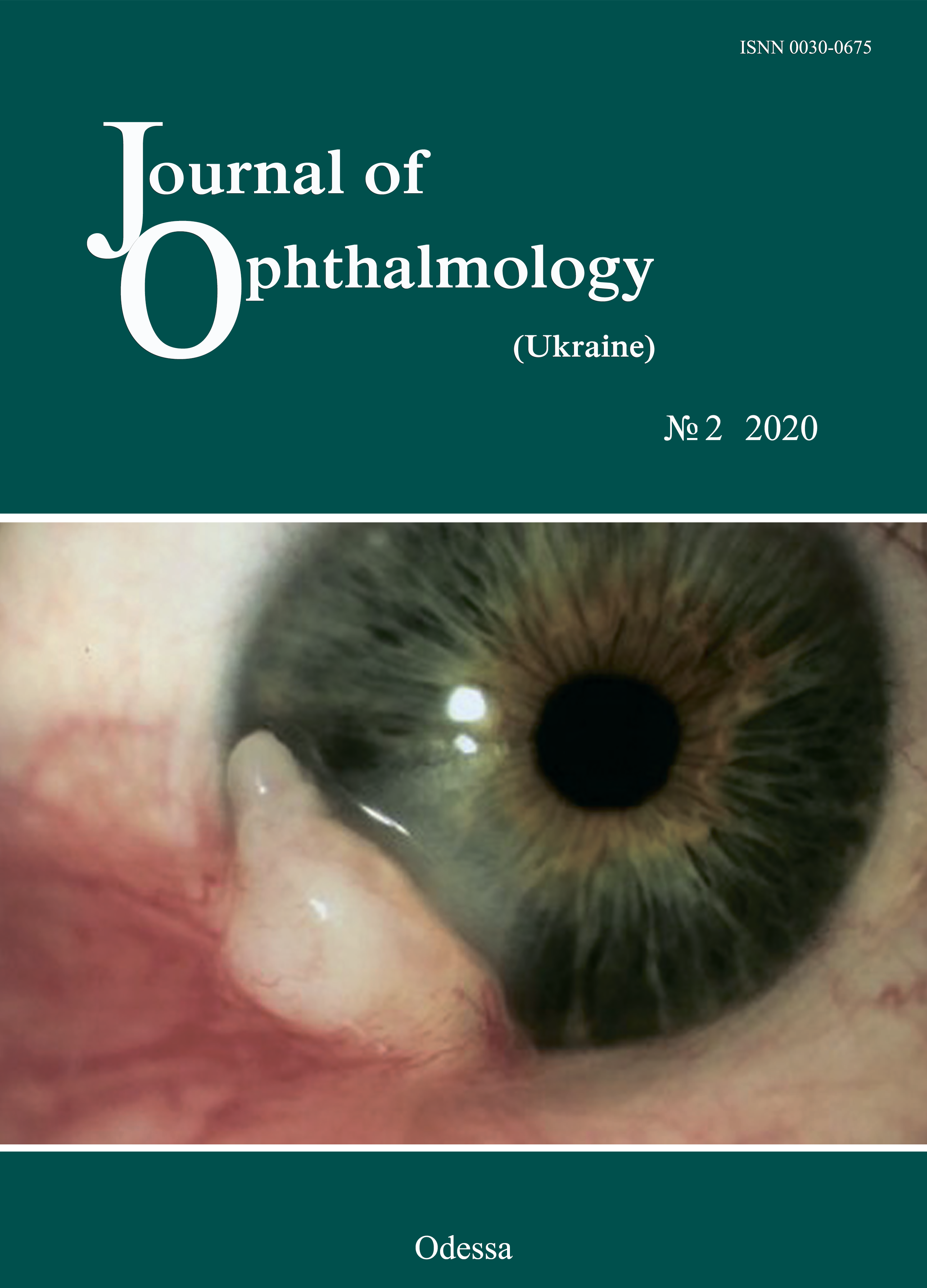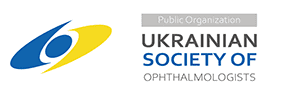Clinical decision support system for extraocular muscle pathology
DOI:
https://doi.org/10.31288/oftalmolzh202027078Keywords:
strabismus, polarizing optical studies, clinical decision support systemAbstract
Background: Integration of clinical decision support systems (CDSS) into clinical practice commonly allows improvements in efficacy of diagnosis, treatment and observation of patients, particularly those with eye disease.
Purpose: To substantiate and develop an automated CDSS for extraocular muscle pathology in strabismus.
Material and Methods: We used polarized light to assess the parameters of interference patterns for 147 patients with strabismus due to abnormal structure and function of extraocular muscles.
Results: The following informative interference pattern parameters were determined based on the results of studies and modeling of interference patterns: interference diamond diagonal segments, angles between two diagonal segments, and angles between the diagonal segment and relevant meridians. The main features of interference patterns for various types of strabismus were identified. An automated system using the above informative interference pattern parameters for clinical decision support for extraocular rectus muscle pathology in strabismus was proposed.
Conclusion: Application of the proposed CDSS with enable the ophthalmologist to obtain information on the structural and functional state of the extraocular rectus muscles in 2 to 3 minutes. In addition, it will enable him/her to judge the state of the extraocular oblique muscles indirectly if the symmetrical corneal interference pattern is obtained for the strabismic eye.
References
1.Clinical Decision Support (CDS). Office of the National Coordinator for Health Information Technology. 2013 [cited 31 August 2017]. Available from: https://www.healthit.gov/policy-researchers-implementers/clinicaldecisio.
2.Miller RA. Medical diagnostic decision support systems - past, present, and future: a threaded bibliography and brief commentary. J Am Med Inform Assoc. 1994 Jan-Feb;1(1):8-27. https://doi.org/10.1136/jamia.1994.95236141
3.Kobrinsky BA. [Decision Support Systems in Public Health Services and Training]. Vrach i informatsionnyie tekhnologii. 2010;2:39-45.
4.Yao W, Kumar A. CONFlexFlow: integrating flexible clinical pathways into clinical decision support systems using context and rules. Decis Support Syst. 2013;55(2):499-515.https://doi.org/10.1016/j.dss.2012.10.008
5.Castaneda C, Nalley K, Mannion C, Bhattacharyya P, Blake P, Pecora A, Suh KS. Clinical decision support systems for improving diagnostic accuracy and achieving precision medicine. J Clin Bioinforma. 2015 Mar 26;5:4.https://doi.org/10.1186/s13336-015-0019-3
6.Litvin AA, Litvin VA. [Clinical decision support systems for surgery]. Novosti khirurgii. 2014;22(1):96-100.https://doi.org/10.18484/2305-0047.2014.1.96
7.Liberati EG, Ruggiero F, Galuppo L, Gorli M, Gonzalez-Lorenzo M, Maraldi M, et al. What hinders the uptake of computerized decision support systems in hospitals? A qualitative study and framework for implementation. Implement Sci. 2017 Sep 15;12(1):113.https://doi.org/10.1186/s13012-017-0644-2
8.Paunksnis A, Barzdziukas V, Jegelevicius D, Kurapkiene S, Dzemyda G. The use of information technologies for diagnosis in ophthalmology. J Telemed Telecare. 2006;12 Suppl 1:37-40.https://doi.org/10.1258/135763306777978443
9.Sumeet D, Mohit J. Computational Decision Support Systems and Diagnostic Tools in Ophthalmology: A Schematic Survey. In: Computational Analysis of the Human Eye with Applications. World Scientific Publishing. 2015.
10.Trikha S. AI decision support systems for Ophthalmic care - the competitive advantage? Dec 30, 2017, 08.05 AM IST. Available from: https://health.economictimes.indiatimes.com /health-files/ai-decision-support-systems-for-ophthalmic-care-the-competitive-advantage/2781
11.Kahai P, Namuduri KR, Thompson H. A decision support framework for automated screening of diabetic retinopathy. Int J Biomed Imaging. 2006;2006:45806.https://doi.org/10.1155/IJBI/2006/45806
12.Noronha K, Acharya U, Nayak K, Kamath S, Bhandary S. Decision support systemfor diabetes retinopathy using discrete wavelet transform. Proc Inst Mech Eng H. J Eng Med. 2013: 227(3):251-61.https://doi.org/10.1177/0954411912470240
13.Kumar SJJ, Madheswaran M. An improved medical decision support system to identify the diabetic retinopathy using fundus images. J Med Syst. 2012 Dec;36(6):3573-81.https://doi.org/10.1007/s10916-012-9833-3
14.Xiao D, Vignarajan J, Lock J, Frost S, Tay-Kearney M-L, Kanagasingam Y. Retinal image registration and comparison for clinical decision support. Australas Med J. 2012;5(9):507-12.https://doi.org/10.4066/AMJ.2012.1364
15.Li Zhang. An intelligent mobile based decision support system for retinal disease diagnosis. J Health Med Informat. 2014;59:341-50.https://doi.org/10.1016/j.dss.2014.01.005
16.Prasanna P, Jain S, Bhagat N, Madabhushi A. Decision support system for detection of diabetic retinopathy using smartphones. In: Pervasive Computing Technologies for Healthcare (Pervasive Health). 2013. International Conference on 2013, pp. 176-179. https://doi.org/10.4108/pervasivehealth.2013.2520937th
17.Bourouis A, Feham M, Hossain MA, Zhang L. An intelligent mobile based decision support system for retinal disease diagnosis. Decis Support Syst. 2014;59:341-50. https://doi.org/10.1016/j.dss.2014.01.005
18.Piri S, Delen D, Tieming LT, Zolbanin HM . A data analytics approach to building a clinical decision support systemfor diabetic retinopathy: Developing and deploying a model ensemble. Decis Support Syst. 2017 September; https://doi.org/10.1016/j.dss.2017.05.012
19.Kern C, Fu DJ, Kortuem K, Huemer J, Davis A, Balaskas K, et al. Implementation of a cloud-based referral platform in ophthalmology: making telemedicine services a reality in eye care. Br J Ophthalmol. 2019. doi:10.1136/ bjophthalmol-2019-314161.
20.L?pez MM, L?pez MM, de la Torre D?ez I, Jimeno JC, L?pez-Coronado M. A mobile decision support system for red eye diseases diagnosis: experience with medical students. J Med Syst. 2016 Jun;40(6):151. https://doi.org/10.1007/s10916-016-0508-3
21.Vitovska OP, Savina OM. [The structure and sickness rate of eye and adnexa diseases in children in Ukraine]. Medicni perspektivi. 2015; .XX (3): 133-8. Ukrainian.https://doi.org/10.26641/2307-0404.2015.3.53698
22.Lu J, Feng J, Fan Z, Huang L. Automated Strabismus Detection based on Deep neural networks for Telemedicine Applications. Available from:https://www.researchgate.net/profile/Jiewei_Lu
23.Yang Z, Fu H, Li R, Lo W-L. Intelligent Evaluation of Strabismus in Videos Based on an Automated Cover Test. Appl Sci. 2019;9:731-47.https://doi.org/10.3390/app9040731
24.Yehezkel O, Belkin M, Wygnanski-Jaffe T. Automated Diagnosis and Measurement of Strabismus in Children. Am J Ophthalmol. 2019 Dec 27. pii: S0002-9394(19)30619-1.
25.Strabo care system. Available from: https://strabo-care.com. Russian.
26.Aznauryan IE, Balasanyan VO, Kudryashova EA, Uzuev MI. [StraboCare technology for dosing friendly strabismus surgery]. In: Proceedings of the 1st Intenational conference for ophthalmologists and strabismologists. STRABO 2019. New technologies in the diagnosis and treatment of ocular motility pathology. Moscow, 2019. p.7. Russian.
27.Bushueva NN, Romanenko DV, Tarnopolska IN. [Results of the surgical treatment of associated squint with preliminary modeling of operations by using three-dimensional biomechanical model of the eye]. Oftalmol Zh. 2014;1:18-23. Russian.
28.Romanenko DV, Bushuyeva NN, Dukhayer S, Pelypenko OV. [Assessment of extraocular muscle motility in patients with concomitant and non-concomitant strabismus with vertical component using automated analysis of two-dimensional eye globe pictures in diagnostic gaze positions]. Oftalmol Zh. 2014;5:15-9. Russian.
29.Brewster D. Experiments on the depolarization of light as exhibited by various mineral, animal and vegetable bodies with a reference of the phenomena to the general principles of polarization. Phil Trans Roy Soc Lond. 1815;1:21-53.
30.Cogan DC. Some ocular phenomena produced with polarized light. Arch Ophthalmol. 1941;25(3):391-400.https://doi.org/10.1001/archopht.1941.00870090013001
31.Stanworth A. Polarized light studies of the cornea II. The effect of intraocular pressure. J Exp Biol. 1953;30(2):164-9.https://doi.org/10.1242/jeb.30.2.164
32.Stanworth A, Naylor EJ. The polarization optics of the isolated cornea. Br J Ophthalmol. 1950;34(4):201-11.https://doi.org/10.1136/bjo.34.4.201
33.Stanworth A, Naylor E J. Polarized light studies of the cornea I. The isolated cornea. J Exp Biol. 1953;30:160-3.https://doi.org/10.1242/jeb.30.2.160
34.Zandman F. The photoelastic effect of the living eye. Experim Mechanics. 1966;6(5):19-25.https://doi.org/10.1007/BF02327314
35.Penkov MA, Kochina ML. [Interference method in strabismus diagnosis]. Vestn Oftalmol. 1981 Jan-Feb;(1):39-41. Russian.
36.Vodovozov AM, Kovylyn VV. [The use of an optical polarization method for the evaluation of oculomotor muscle function in vertical deviation]. Oftalmol Zh. 1990;(4):201-4. Russian.
37.Bosenko TA. [Diagnosis of asymmetry of the outer muscles of the eye in polarized light with squint]. Aktualnye voprosy oftalmologyy: sbornyk nauchnykh trudov. Kharkiv; 1987:33-5. Russian.
38.Kochina ML, Demin YuA, Kovtun NM, Kaplin IV. [Model of stress-strain state of the cornea of the eye]. East European Scientific Journal. 2017; 2(18):61-66. Russian.
39.Kochyna ML, Kalymanov VG. [Results of modeling the stress - strain state of the cornea of the eye using the ANSYS engineering analysis system]. Klynycheskaya informatika i telemeditsina. 2009;5(6):26-30. Russian.
40.Kochina M L, Kovtun NM. [Results of Modeling the Stress-Strain Stat of the Eye Cornea with Extraocular Muscles Pathology]. Ukrainian journal of medicine, biology and sport. 2020;5(23):135-43.
41.Kochyna ML, Kalymanov VG. [Classification of oculomotor muscle lesions using fuzzy logic apparatus]. Kibernetika i vychislitelnaya tekhnika. 2011;166: 97-107. Russian.
42.Kochina ML, Demin YuA, Kovtun NM, Kaplin IV. [Peculiarities of interferential pictures of eyes at horizontal heterotropy]. Ukrainian journal of medicine, biology and sport. 2017;2(4):75-81. Russian.https://doi.org/10.26693/jmbs02.02.075
43.Kovtun NM. [Interference Patterns of the Eye Cornea with Different States of Oculomotor Muscles]. Ukrainian journal of medicine, biology and sport. 2017; 2(6): 81-86. Russian.https://doi.org/10.26693/jmbs02.06.081
44.Kaplin IV, Kochina ML, Demin YuA, Firsov AG. [The conception of telemedicine system for express estimation of intraocular pressure's level]. Kibernetika i vychislitelnaya tekhnika. 2018;1 (191):76-94. Ukrainian.https://doi.org/10.15407/kvt191.01.076
Downloads
Published
How to Cite
Issue
Section
License
Copyright (c) 2025 М. Л. Кочина, Ю. А. Дьомін, О. В. Яворський, Н. М. Ковтун, О. Г. Фірсов

This work is licensed under a Creative Commons Attribution 4.0 International License.
This work is licensed under a Creative Commons Attribution 4.0 International (CC BY 4.0) that allows users to read, download, copy, distribute, print, search, or link to the full texts of the articles, or use them for any other lawful purpose, without asking prior permission from the publisher or the author as long as they cite the source.
COPYRIGHT NOTICE
Authors who publish in this journal agree to the following terms:
- Authors hold copyright immediately after publication of their works and retain publishing rights without any restrictions.
- The copyright commencement date complies the publication date of the issue, where the article is included in.
DEPOSIT POLICY
- Authors are permitted and encouraged to post their work online (e.g., in institutional repositories or on their website) during the editorial process, as it can lead to productive exchanges, as well as earlier and greater citation of published work.
- Authors are able to enter into separate, additional contractual arrangements for the non-exclusive distribution of the journal's published version of the work with an acknowledgement of its initial publication in this journal.
- Post-print (post-refereeing manuscript version) and publisher's PDF-version self-archiving is allowed.
- Archiving the pre-print (pre-refereeing manuscript version) not allowed.












